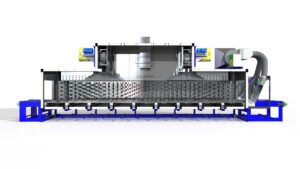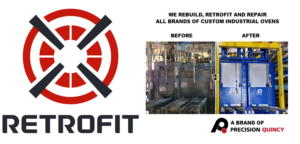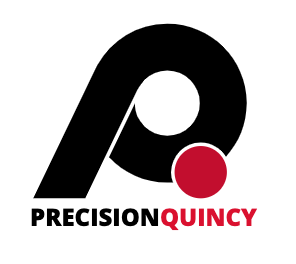
Although there can be significant differences in design, all custom industrial ovens are bound by a common set of first order engineering principles, and any design of an industrial oven must meet the standards promulgated by the National Fire Protection Association (NFPA).
These principles and standards become the roadmap for any retrofit or repair project for a custom industrial oven. And our engineers have a proven track record of using this roadmap, coupled with modern design and manufacturing technology, to successfully repair and retrofit ANY BRAND of industrial ovens for any application or process.
We have outlined nine common upgrades in retrofit and repair projects for custom industrial ovens. These upgrades are not mutually exclusive. Every retrofit and repair project is different and tailored to the needs of the customer and the limitations of its existing equipment.
1. Improve Temperature Uniformity
Poor temperature uniformity can result from one of these three things: (1) cold air leaking from outside the oven into the workroom area; (2) losing energy through the shell of the oven while retaining the air; and (3) inadequate mixing of heated and recirculated air exiting the supply ducts causing hotspots.
Temperature uniformity can be improved by modifying the oven’s design to ensure that the heated and recirculated air is mixed properly. Our engineers use computational fluid dynamics software as well as proven design techniques to redesign an oven’s recirculation system to ensure the air exiting supply ducts is properly mixed. Once this is established, our engineers will analyze whether there is an even temperature loss throughout the shell of the oven and may increase or change the insulation within the oven shell to address a lack of uniformity.
It is interesting to note that if an oven’s internal pressure is positive, the leaking of air through openings in the oven does not cause bad uniformity: it only results in loss of energy. But if an oven’s internal pressure is negative, then all openings or seams must be properly sealed to ensure that cold air does not enter the oven in any place except the fresh air hole in the heat chamber.
2. Increase Heat Power
The original design of a custom industrial oven may need to be upgraded, either because your product or process has changed, or because the custom oven was not designed correctly in the first place. A common design issue relates to the correct sizing of the heat power to the oven.
When a product or process changes, there may be a need to increase heat power in the equipment. In some cases, this is achieved by simply increasing the existing output from the burners. But in other cases, a new burner or heater bank must be designed and installed.
When increasing the heat power to the oven, it is often necessary to also increase the recirculation air volume. We have extensive experience in redesigning ovens to incorporate increased heat output, and to repair deficiencies in the original oven design, specifications and construction.
3. Decrease Part Ramp-Up Time
We think of an oven as an energy transfer device. The primary way to decrease part ramp-up times is to increase the velocity and volume of air as it travels through the workroom area and heats up those parts. In this process, the recirculation system, including the supply and return ducts, may need to be redesigned to ensure that all surfaces of the product processed in the industrial oven are exposed to rapidly moving air, and that this air is able to freely return to the heat source.
A common issue in the original design of a custom industrial oven is to not match the static pressure capacity of the recirculation fan with the size and length of the recirculation ductwork. For example, if the static pressure of the recirculation fan is two inches of water (as in, the suction needed to draw water two inches in a straw), but the orifice through which air is injected into the workroom area has a pressure drop of the same two inches, then the volume will decrease and not enough air mass will be transported to ensure temperature uniformity and minimize temperature drop through the workroom area.
4. Upgrades to Oven Shell Construction
Some industrial ovens are manufactured with a shell that is not robust enough for the expected life cycle of the equipment. This is often caused by original manufacturers’ attempts to reduce costs in the construction of the shell by minimizing welds or fasteners. At other times, manufacturers do not utilize construction methodologies that incorporate the proper amount of expansion and contraction space that is needed when the oven experiences high thermal stress.
Another issue causing premature failure of an oven’s shell is connected to the materials used to construct the shell which can experience corrosion under certain conditions. For example, using aluminized steel in an environment that processes large amounts of water may be an adequate material as long as stainless steel drip pans are incorporated into the base, but sometimes these drip pans are not incorporated into the original design; and as a result, rust and corrosion can develop at the bottom of the oven shell. As another example, utilizing galvanized panels instead of aluminized or stainless steel can result in premature corrosion if the panels are exposed to certain chemicals.
5. Improve Reliability
Costly oven downtime is often caused by design, construction or installation issues that date back to the original commissioning of the new equipment. Many of our retrofit and repair projects result from our customers’ desire to improve the reliability of their custom oven. For example, when fans, conveyors or other rotating components are not mounted properly in an effort by the original manufacturer to reduce costs, it can cause vibrations that will cause the premature failure of bearings and other rotary components.
In addition, when the wrong materials are used in oven components, those components can fail prematurely. A common problem is to use mild steel fan wheels when the temperature in the workroom area is higher than the temperature recommended for the fan wheel. Original manufacturers sometimes mistakenly base their calculations on the maximum workroom temperature and do not factor in the higher temperature in the heat chamber.
Issues in the assembly process can also cause premature failure of components. For example, tightening screws on both sides of an air kit can destroy some of the bearings as the shaft expands.

6. Ease of Maintenance
Maintenance access is not a design priority for most manufacturers of custom industrial ovens. Cost is often mentioned as the reason for this design philosophy. For this reason, many industrial ovens are designed with minimal accessibility for basic maintenance functions, but do not allow for the repair or replacement of major components like fan wheels or fan shafts. As a result, customers continue to use components that should have been replaced after their recommended useful life. This increases the probability of costly downtime and damage to the oven.
We have a different design philosophy regarding maintenance access. We believe that you can design for ease of maintenance and keep costs down. For this reason, we always visualize service operations in the design phase of our retrofit and repair projects.
7. NFPA Safety Compliance
Compliance with NFPA safety standards is a necessity for any thermal processing equipment. See our White Paper on Industrial Oven Safety 101: Understanding NFPA 86, among other resources.
Typically, a Class A oven requires one square foot of explosion relief for every 15 cubic feet of internal oven volume. We retrofit industrial ovens to add explosion relief to ensure NFPA 86 compliance.
Class A ovens also need exhaust to process volatile organic compounds (VOCs). NFPA regulations also require that exhaust be drawn from an oven in the location of the highest concentration of VOCs. We will retrofit an existing oven to ensure that the exhaust complies with these NFPA standards.
Other retrofit projects require that we redesign the fuel train to meet NFPA standards.
8. Upgrade Controls
We will upgrade controls as part of retrofit projects for custom industrial ovens. Sometimes these are called re-control projects. These upgrades will increase the quality of the controls; give the operator more feedback on the thermal process; increase the accuracy of the controls; or minimize over-processing. These control upgrades include adding a data acquisition system; encryption that conforms to NADCAP or CQI-9 standards; and ramp soak and closed-loop temperature control.
9. Increase Volume or Extend Length of Oven
Retrofit and repair projects are sometimes needed when a customer changes their product or process. We have worked with customers to lengthen or increase the size of their custom oven to accommodate changes in their manufacturing. These retrofit projects often also include other upgrades discussed above, but keep in mind that there is often room in an existing oven to upgrade certain components to allow for higher throughput or extend the oven with minimal reduction in performance.


